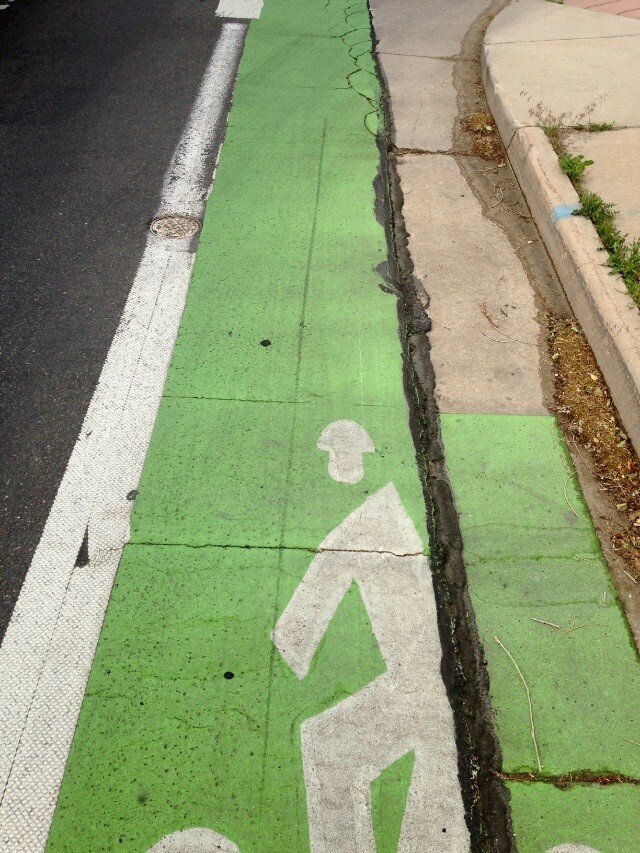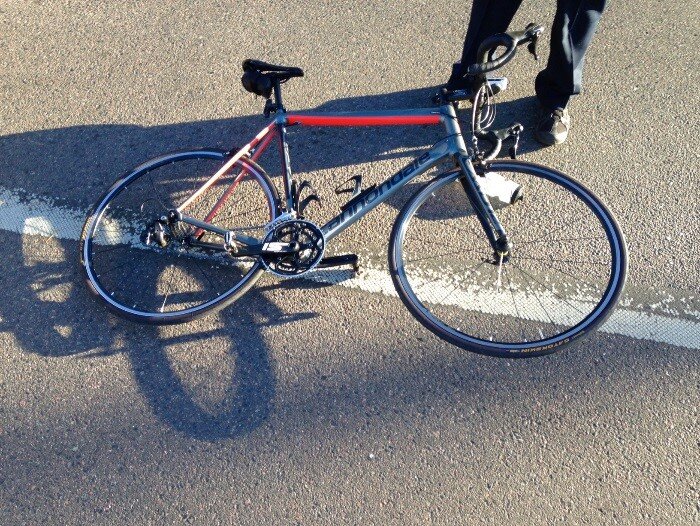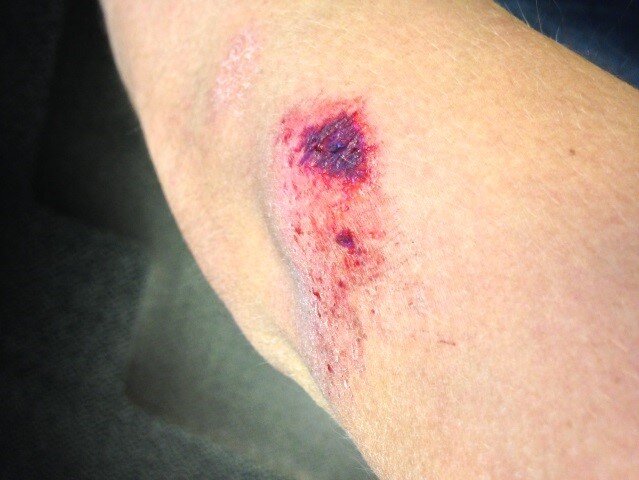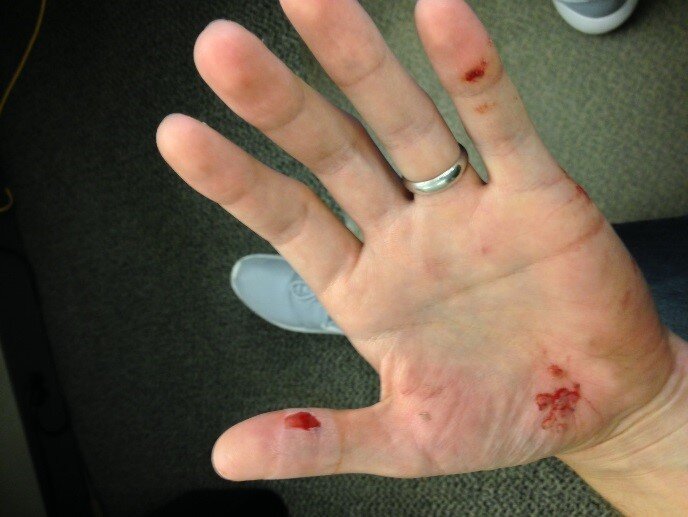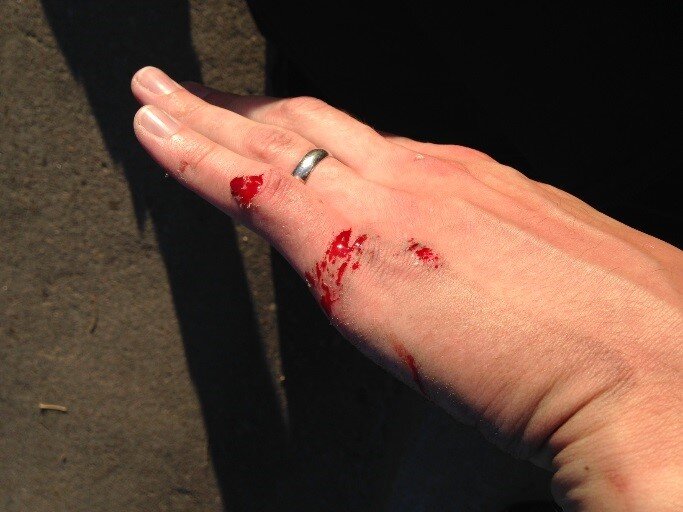Cameras, computers, and crash alerts necessary to keep cyclists safe
Not only does cyclist Anthony Hardwick recommend riding with cameras, computers, and crash alerts to keep cyclists safe, he also wants to emphasize the importance of technology to document motorists when they are not being safe.
The driver who hit Anthony tried to wiggle her way out of accepting responsibility for the crash and even tried to pin blame on him by saying that Anthony was speeding in a school zone. In court, Anthony was able to point to his Garmin data and prove that he was not traveling above the speed limit. “The computer holds them accountable,” said Anthony. He has also invested in cameras that cost him $60 total which he runs front and rear facing now, just in case. Anthony strongly encourages any bicycle rider to get a cycling computer that sends an alert via your cell phone in the event of a crash, or find a cell phone app that does the same. “Having loved ones at the scene to help you make decisions when you’re concussed is so invaluable. I was a groggy mess and my wife’s help was so wonderful.” Traffic camera footage, if available, can also be useful in holding drivers accountable.
Anthony, a Bicycle Service Department Manager, has been riding bikes since he was in college back in 2006. He enjoys group rides and competition but mostly rides for transportation purposes. On January 22, 2020, Anthony had been riding the bike path that runs from the South Platte Trail west out to Lakewood. Anthony had gotten off the path and was riding in a bike lane down 10th Avenue.
He had chosen to ride 10th Avenue because there is a wide, demarcated section of the road, a bike and parking lane, that is used by motorists and cyclists who are trying to avoid being in/slowing down traffic. Anthony had just advanced east from the stop light at 10th Ave and Sheridan.
The bike and parking lane begins just past Zenobia Street. As Anthony got closer to Cowell Elementary School, more and more parked cars were in the lane, and he was forced out into the car traffic section of the road. In addition, he was trying to be mindful of the school zone speed limit and had slowed to middling speed as denoted by this graphic from his Garmin:
Anthony returned to the parking/bike lane past Utica Street. Right then and there, an SUV that had just passed him seconds earlier turned right into the alley just in front of Anthony. The driver did not signal the turn or yield to him. Anthony crashed into the back passenger corner of the Acura RDX and was thrown from his bicycle.
Anthony was terrified as he smashed into the back of the car. “I thought I might break my neck and die. I literally thought ‘My neck is breaking’ as the impact was made. As I lay on the pavement, I wiggled my toes in my shoes and realized I wasn’t paralyzed and I could still breathe, so then I was just really really mad,” explained Anthony.
He lay in the street for several minutes because he didn’t want to move knowing that this could cause paralysis after an impact. However, bystanders moved him out of the road to the sidewalk. Anthony was disoriented, and a person asked if he wanted to have 911 called. He nodded his head “yes” because he was feeling very shaken up and was worried that he was hurt worse than he could tell. Anthony called his wife. Fire and EMS responded as well as Denver PD. EMS determined that he was not in critical danger and could ride to Denver Health Urgent Care with his wife who was on the way to the scene.
The driver claimed that she did not see Anthony, that he came out of nowhere, and that he was faster than she thought. The Denver Police Department cited the driver with careless driving.
Anthony was diagnosed with a concussion, back muscle strains, neck muscle strain, and a sprained left ring finger. “I am extremely blessed that I didn’t break any bones. My muscles did suffer massive strains and I felt like I had been hit by a truck the next day, mostly because I had been hit by a tiny truck,” said Anthony. He was on bed rest for a week due to the concussion. Anthony missed work from January 22 - February 2, 2020, as he was unable to perform tasks needed to manage the service department. “I felt stressed that I was missing work right after getting promoted to a manager’s position.”
His wife has had to deal with the majority of the insurance issues as they have coverage through her work. Anytime the health insurance company had a question or conflict with something, they did not call me, they called her, because she is the primary contact on the policy. “This stressed the hell out of her,” said Anthony. She also missed work when he was concussed because Anthony needed to be monitored just in case he had brain bleeds.
Anthony appeared in court on June 29th, 2020 to testify at the driver’s hearing. She represented herself and was trying to dodge being at fault. Anthony said that she tried to insinuate that he was not paying attention because he was wearing headphones. “Imagine her surprise when I said that was impossible because I always pull off the ear bud silicon cover on my left ear so that I don’t ride with an ear bud in the ear that is closest to traffic. That is a little trick a police officer in Omaha, NE told me about. This way the driver can’t even play like you had an ear bud in because it won’t stay in your ear!”
The driver was found guilty of careless driving and was assessed four points to her license. She paid $135.00 in fines and fees. “It was only four points on her license and she got to keep her driving privileges. I was surprised … but that is the state of affairs until those who write the laws start taking road cycling seriously as a means of transport.”
“Once again, we have a situation here where we have adequate laws on the books- the VRU law, among others - but we have city attorneys and DAs unwilling to use those laws fully. Anytime a plea deal is offered like it was here, the laws we fight so hard for, go unused, un-utilized. Driving behavior will not change until DAs and City Attorneys start taking away drivers’ licenses... until the PRIVILEGE of driving is suspended for a period of time.”
Anthony feels that the outcome of the civil case was fair, and that he was compensated well for his injuries and his bicycle. However, he said it is hard to feel like the justice system is taking cyclists being hit seriously when the drivers who hit cyclists are allowed to keep their licenses. He is reminded of something an EMT professor said in class once: “Don’t call car crashes accidents. It’s not an accident when someone is being careless, distracted, or an a-hole. That’s just someone causing a car crash.”
Until the justice system feels the same way, cyclists need to be diligent in everything they do on the roads.
The crash has affected how Anthony feels about riding his bike in general. “I can’t ride in traffic because I fear getting cut off again.” He frequently discusses moving from Denver, because he wants to live in a smaller town with fewer people and, thus, fewer cars on the roads. Anthony is seriously considering uprooting his family and moving to Grand Junction, CO, because people tell him that GJ is what Denver and Boulder were like “in the good ole days.”
While not afraid to ride his bike, Anthony is much more hesitant to proceed on his course when cars pass him now. “I find myself instinctively using the brakes when a car passes me. I do not trust drivers to have common sense anymore.” Anthony has greatly altered his route to work. He tries to only use Denver bike lanes as that is a clear lane of travel with solid white lines meant to deter drivers from entering his lane of travel. However, he still sees drivers ignore this paint and drive wherever they please. This has led him to do most of his training rides in more rural areas, like the Eastern Plains, or beyond the front range mountains deeper into the Rockies. This means that Anthony drives his car more just to get to a place where he feels safe riding.
If Anthony could speak to the driver directly, he would say the following:
“How much time did you save now? You were trying to fly past me in a school zone and bank a hard right turn at just under 30 mph, with your baby in the car! For what? To shave fifteen seconds off your afternoon commute time? You told me you were just trying to drop your baby off and then go back to the school to pick up your kid or something. The exponential growth of your poor time management is astounding. You didn’t give yourself enough time to do the things you felt you needed to do as a parent, and rushed around in a car trying to make up for lost time. How much time did you lose after you hit me? You lost the time of giving a statement to the police officer that day. You lost the time trying to find a lawyer to defend your indefensible case. You lost the time acting as your own defense in court. You lost the time making a statement to your insurance company for the settlement. You lost hours of your life trying to get back 15 seconds. Next time, just wait for me to pass and those lost 15 seconds will save you hours of lost life.”
Anthony wants all cyclists to know to carry underinsured motorist coverage on their own insurance policies and to get their insurance ducks in a row. He also recommends contacting a lawyer right away as the process can be long. “The sooner a lawyer is calling people on your behalf the quicker it will be finished.”










